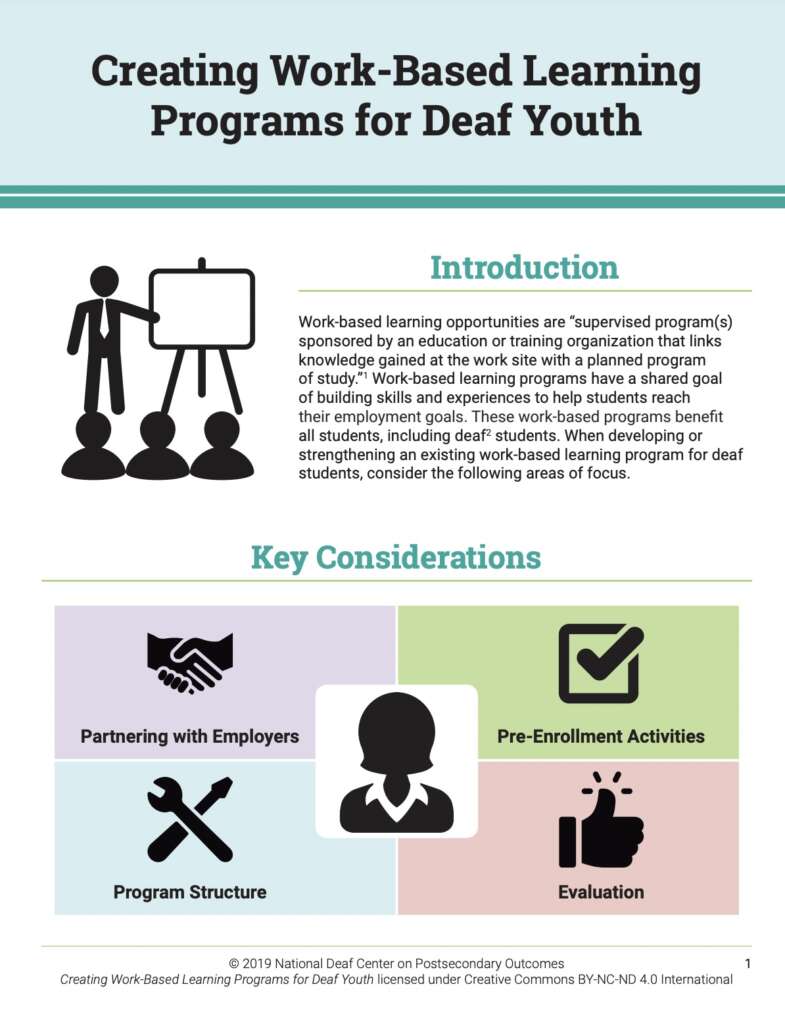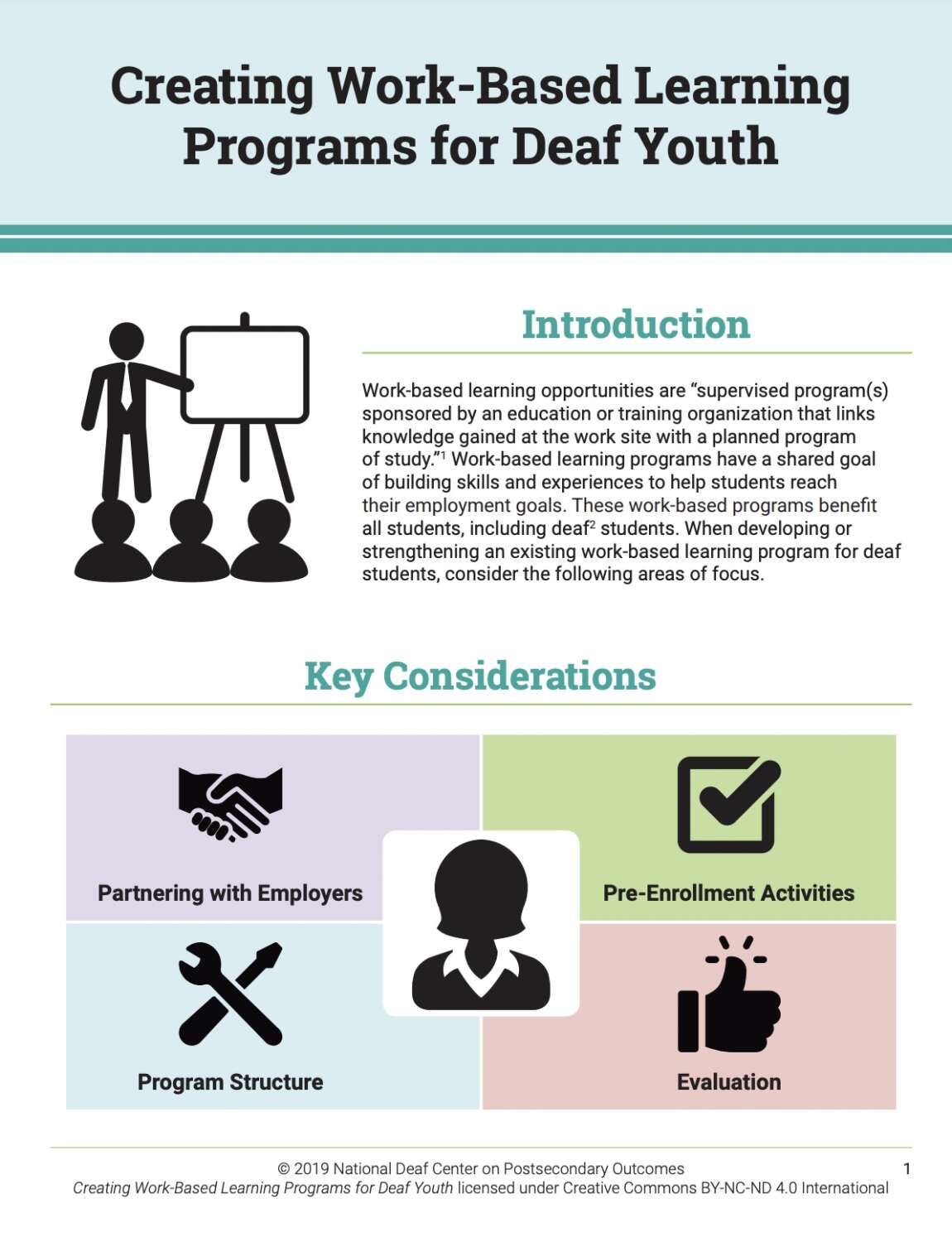Introduction
Work-based learning opportunities are “supervised program(s) sponsored by an education or training organization that links knowledge gained at the work site with a planned program of study.”1 Work-based learning programs have a shared goal of building skills and experiences to help students reach their employment goals. These work-based programs benefit all students, including deaf2 students. When developing or strengthening an existing work-based learning program for deaf students, consider the following areas of focus.
Key Considerations

Partnering With Employers
Develop partnerships with employers, as collaboration is a critical component to all work-based learning programs.
- Engage with a variety of employers to allow students access to a range of work-based learning experiences.1
- Offer site-wide training to partners to cover expectations and provide an introduction to working with deaf students.
- Collaborate with vocational rehabilitation agencies to develop on-the-job training opportunities.
- Educate businesses to understand the benefits of participating in work-based learning programs, including financial incentives from vocational rehabilitation agencies and the federal government to assess, train, and hire students with disabilities.3
- Collaborate with agencies, community rehabilitation partners, and intermediaries who have current relationships with individual businesses to reduce the amount of time and effort to place students in work-based learning programs. Doing so also reduces the time needed to design curricula and assess student and employer experiences.4, 5, 6, 7
Pre-Enrollment Activities
- Integrate self-advocacy training into your student onboarding process.
- Provide assessments for students to self-identify interests and strengths.
- Determine the level of support needed for each student’s placement.
- Provide training on the purpose of work-based and experiential learning for students and partners.
- Host a meet-and-greet or transition fair and provide activities that encourage students and partners to discuss expectations and placement responsibilities.
- Host orientations for the students, the business, and other stakeholders involved in the process.
Program Structure
- Develop plans with learning goals that fit individual youth with specific outcomes connected to their learning.1
- Clearly define roles and responsibilities for students, employer contacts, school contacts, and support staff.1
- Provide academic, social, and administrative support for students and employers.1
- Match students with employers through a career interest survey for students and a needs assessment for employers.1
- Design the program to balance the time students spend learning in school and at the employer site. The ideal balance depends on the industry, student needs, and amount of time professionals have to dedicate to the program.8
- Provide accessible work-based learning opportunities by engaging with the student and employer to ensure that the needs of students are met using things like auxiliary aids, services, and supports.9
- Provide opportunities for students to reflect on their experiences and meet with trusted mentors to discuss challenges, barriers, and future opportunities.
- Provide accessibility and cultural sensitivity education training about deaf students for supervisors and employers.
Evaluation
- Track specific learning goals and progress toward those goals.
- Track the number of community partners and the number of placements from year to year.
- Collect data by surveying students and employers about their work-based learning experiences.
- Collect field stories of student experiences for qualitative data.
- Create an ongoing dialogue with all stakeholders to improve practices.
- Identify what you are measuring by examining program goals (e.g., outcomes, behaviors, relationships).
- Decide how to collect data (e.g., surveys, interviews, focus groups). Consider data collection approaches that are most accessible for a range of deaf youth.
Notes and References
1 Federal Partners in Transition. (2015). What to know about work-based learning experiences for students and youth with disabilities. Retrieved from www.ed.gov
2 NDC uses the term deaf in an all-inclusive manner, to include people who identify as deaf, deafblind, deafdisabled, hard of hearing, late-deafened, and hearing impaired. NDC recognizes that for many people, identity is fluid and can change over time or with setting. NDC has chosen to use one term, deaf, with the goal of recognizing experiences that are shared by people from diverse deaf communities while also honoring their differences.
3 Division of Vocational Rehabilitation, Florida Department of Education. On the job training. Retrieved from www.rehabworks.org
4 College and Career Readiness and Success. (2017). What are work-based learning intermediaries? Retrieved from www.ccrscenter.org
5 Darche, S., Nayar, N., & Bracco, K. (2009). Work-based learning in California opportunities and models for expansion. San Francisco, CA: WestEd.
6 Luecking, R., Deschamps, L., Allison, R., Hyatt, J., & Stuart, C. (2015). A guide to developing collaborative school-community-business partnerships. Charlotte, NC: National Technical Assistance Center on Transition.
7 WINTAC. (2016a). CRP pre-ETS guidebook. Retrieved from https://transcen.org/wp-content/uploads/2020/05/CRP_WINTAC.pdf
8 Kis, V. (2016). Work-based learning for youth at risk: Getting employers on board. Paris, France: The Organisation for Economic Co-operation and Development (OECD).
9 WINTAC. (2016b). Pre-employment transition services FAQs. Retrieved from https://transitionta.org/topics/pre-ets/






